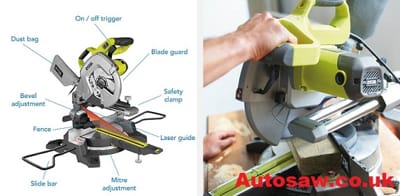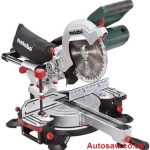As an Amazon Associate, I earn from qualifying purchases.

A miter saw is a tool used for making precise cuts in wood. It is important to know how to use a miter saw properly in order to get the best results. Here are some tips on how to use a miter saw
Contents
How To Use a Mitre Saw?
A mitre saw, also known as a chop saw or drop saw, is a power tool that is used for making precise cross cuts and angled cuts in wood or other materials. Here are the steps for using a mitre saw:
- Set up the saw on a stable work surface, such as a workbench or sawhorse.
- Adjust the blade angle to the desired angle. Most mitre saws have a scale and protractor on the base to help you set the blade at the correct angle.
- Secure the workpiece to the saw table using clamps or a vice. Make sure the workpiece is held firmly in place and won’t move while you’re cutting.
- Turn on the saw and allow the blade to come up to full speed.
- Slowly lower the saw blade onto the workpiece, making sure to keep your hands and body clear of the blade.
- Guide the saw along the cutting line, applying steady pressure to keep the blade moving through the material.
- When the cut is complete, turn off the saw and allow the blade to come to a complete stop before removing the workpiece.
- Use a push stick or similar tool to help guide and support the workpiece while cutting, especially when making narrow cuts. This will help to keep your hands safely away from the blade.
What is a mitre saw?
A mitre saw is a type of saw that is used to make precise cuts at specific angles. The blade is mounted on a swing arm that pivots left or right, allowing the user to make angled cuts. Mitre saws can make cuts at various angles, including 45 and 90 degrees.
Types of mitre saws
There are three main types of mitre saws: basic, compound, and sliding compound.
Basic mitre saw
A basic mitre saw is the simplest and most affordable type of mitre saw. It can only make angled cuts, but it is perfect for simple DIY projects.
Compound mitre saw
A compound mitre saw can make angled cuts and bevel cuts, making it more versatile than a basic mitre saw. It is ideal for more complex woodworking projects.
Sliding compound mitre saw
A sliding compound mitre saw can make angled cuts, bevel cuts, and compound cuts. It is the most versatile type of mitre saw, making it perfect for professional carpenters.
Safety precautions
Safety should always be your top priority when using a mitre saw. Here are some safety precautions you should take:
- Wear safety goggles to protect your eyes from sawdust and debris.
- Wear ear protection to protect your ears from the noise.
- Keep your hands away from the blade at all times.
- Do not wear loose clothing or jewelry that could get caught in the saw.
- Keep the saw blade guard in place.
- Always unplug the saw when changing the blade or making adjustments.
Setting up your mitre saw
Before using your mitre saw, you need to set it up properly. Here are the steps you need to follow:
- Place the saw on a flat and stable surface.
- Adjust the saw’s height so that the blade is at the right level for your workpiece.
- Adjust the fence to the right distance from the blade.
- Make sure the blade is securely attached to the saw.
- Check the blade’s alignment to ensure that it is straight and true.
Making angled cuts
Making angled cuts is the most basic use of a mitre saw. Here’s how to do it:
- Measure the angle you want to cut.
- Adjust the saw’s swing arm to the correct angle.
- Hold your workpiece securely against the fence.
- Turn on the saw and lower the blade onto the workpiece.
- Make the cut slowly and steadily, keeping your hands away from the blade.
Making bevel cuts
Bevel cuts are cuts made at an angle along the thickness of the workpiece. Here’s how to make bevel cuts with your mitre saw:
- Adjust the bevel angle on your saw.
- Secure your workpiece against the fence and the table of the saw.
- Turn on the saw and lower the blade slowly and steadily onto the workpiece.
- Make sure the blade cuts through the workpiece at the desired angle.
Making compound cuts
Compound cuts are cuts made at an angle along both the thickness and the width of the workpiece. Here’s how to make compound cuts with your mitre saw:
- Adjust the bevel angle and the mitre angle on your saw.
- Secure your workpiece against the fence and the table of the saw.
- Turn on the saw and lower the blade slowly and steadily onto the workpiece.
- Make sure the blade cuts through the workpiece at the desired angles.
Cleaning and maintaining your mitre saw
Cleaning and maintaining your mitre saw is essential to keep it in good condition and ensure its longevity. Here are some tips for cleaning and maintaining your mitre saw:
- Always unplug the saw before cleaning it.
- Clean the saw blade and the table with a soft brush or a cloth.
- Check the blade’s alignment regularly and adjust it if necessary.
- Lubricate the moving parts of the saw with oil or grease.
- Store the saw in a dry and clean place.
Common mistakes to avoid
Here are some common mistakes that beginners make when using a mitre saw:
- Not wearing safety gear.
- Not adjusting the saw properly.
- Using the wrong blade for the job.
- Not securing the workpiece properly.
- Rushing the cut.
Using a mitre saw for specific projects
A mitre saw can be used for a wide range of woodworking projects. Here are some examples:
- Cutting baseboards and crown moulding.
- Building a picture frame.
- Making a bookshelf.
- Building a birdhouse.
- Making a wooden toy.
Frequently Asked Questions (FAQs)
Do I need a special blade for my mitre saw?
Yes, you need to use a blade that is compatible with your mitre saw and suitable for the job you are doing.
Can I use a mitre saw to cut metal?
No, a mitre saw is designed for cutting wood and should not be used to cut metal.
Can I make a straight cut with my mitre saw?
Yes, you can make a straight cut by adjusting the saw to a 90-degree angle.
How often should I replace the blade on my mitre saw?
You should replace the blade on your mitre saw when it becomes dull or damaged.
Can I use a mitre saw to cut angles other than 45 and 90 degrees?
Yes, most mitre saws allow you to adjust the angle to any degree.
Conclusion
Using a mitre saw can be intimidating for beginners, but with the right guidance and safety precautions, you can learn to use it safely and effectively. Remember to wear safety gear, adjust the saw properly, and take your time to make precise cuts. With practice, you can use your mitre saw to create beautiful and functional woodworking projects.





